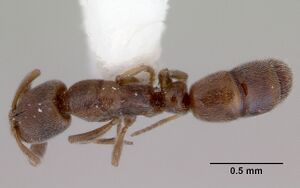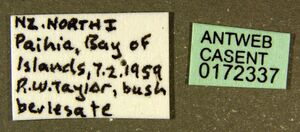Ponera leae
| Ponera leae | |
|---|---|

| |
| Ponera leae | |
| Scientific classification | |
| Kingdom: | Animalia |
| Phylum: | Arthropoda |
| Class: | Insecta |
| Order: | Hymenoptera |
| Family: | Formicidae |
| Subfamily: | Ponerinae |
| Tribe: | Ponerini |
| Genus: | Ponera |
| Species: | P. leae |
| Binomial name | |
| Ponera leae Forel, 1913 | |
| Synonyms | |
| |
Ponera leae is the southern-most species of Ponera in Australia and nearby areas. It occurs in a wide range of habitats from dry sclerophyll woodlands to rainforest and has even been found in pine plantations. It is found on the ground in a variety of situations including leaf litter, rotten wood and between and under stones. While P. leae is probably native throughout most of its current range, it is highly likely that it has been relatively recently introduced into New Zealand.
| At a Glance | • Limited invasive |
Identification
Moderately small size, distinctly 4-segmented antennal club. Pronotal width 0.29 - 0.30 mm; scape index 80-86; entire petiolar node when viewed from directly above forming almost an exact half-circle. There is an incised mesometanotal suture on the worker mesosomal dorsum and the palpal formula in both workers and queens is Maxillary 2: Labial 2.
Keys including this Species
Distribution
Latitudinal Distribution Pattern
Latitudinal Range: -15.28333378° to -43.01666667°.
| North Temperate |
North Subtropical |
Tropical | South Subtropical |
South Temperate |
- Source: AntMaps
Distribution based on Regional Taxon Lists
Australasian Region: Australia (type locality), Lord Howe Island, New Caledonia, New Zealand, Norfolk Island.
Distribution based on AntMaps
Distribution based on AntWeb specimens
Check data from AntWeb
Countries Occupied
| Number of countries occupied by this species based on AntWiki Regional Taxon Lists. In general, fewer countries occupied indicates a narrower range, while more countries indicates a more widespread species. |

|
Estimated Abundance
| Relative abundance based on number of AntMaps records per species (this species within the purple bar). Fewer records (to the left) indicates a less abundant/encountered species while more records (to the right) indicates more abundant/encountered species. |

|
Elevation Range
| Species | Elevation (m asl) | |||||
|---|---|---|---|---|---|---|
| 200 | 400 | 600 | 800 | 1000 | 1200 | |
| Ponera leae | 0-10 | |||||
| Shading indicates the bands of elevation where species was recorded. Numbers are the percentage of total samples containing this species. | ||||||
Biology
This is an abundant and adaptable ant within its range. It is found among the more common ant species in most of the localities in southern and eastern New Caledonia, extending from dry, semideciduous lowland forest at Chapeau Gendarme to the cool, wet clould forest on the summit ridge of Mt. Mou. Colonies are generally small. At Chapeau Gendarme they were found nesting exclusively in large rotting logs, while in the moister forests of Mt. Mou and Ciu they occurred mostly in the soil beneath rocks. Solitary workers were found foraging during the day on the forest floor.
Wilson (1957) noted the following: Two workers were found with a small amount of brood in a small cavity in the undersurface of a rock set deeply in the soil. These individuals were rather sluggish and when prodded with the tip of forceps, rolled up and feigned death for a short while, a behavioral response common in other species of Ponera. All of the other collections of leae (as caledonica) were made by filtering the ants from masses of leaf litter and soil in a Berlese funnel. The collections at Mt. Mou and Chapeau Gendarme were made in relatively dry, semi-deciduous, valley-pocket forests, while that at Ciu was in moister tropical evergreen forest.
Castes
Males are unknown.
 
| |
| . | |
Images from AntWeb
   
| |
| Worker. Specimen code casent0172337. Photographer April Nobile, uploaded by California Academy of Sciences. | Owned by ANIC, Canberra, Australia. |
Phylogeny
| Ponera |
| ||||||||||||||||||||||||||||||||||||||||||||||||||||||||||||
Relationships among selected species of Ponera based on Branstetter & Longino (2019). The focus of this study was the species Ponera exotica and Ponera pennsylvanica.
Nomenclature
The following information is derived from Barry Bolton's Online Catalogue of the Ants of the World.
- leae. Ponera leae Forel, 1913g: 175 (w.) AUSTRALIA (Tasmania). Wheeler, G.C. & Wheeler, J. 1971b: 1210 (l.). Senior synonym of caledonica, excedra, norfolkensis: Taylor, 1967a: 89.
- oculata. Ponera leae subsp. oculata Wheeler, W.M. 1927i: 130, fig. 1 (w.q.) AUSTRALIA. [Junior primary homonym of oculata Smith, F. 1858b: 93, above.] Replacement name: norfolkensis Wheeler, W.M. 1935c: 72.
- norfolkensis. Ponera leae subsp. norfolkensis Wheeler, W.M. 1935c: 72. [Also described as new by Wheeler, W.M. 1935g: 13.] Replacement name for oculata Wheeler, W.M. 1927i: 130. [Junior primary homonym of oculata Smith, F. 1858b: 93.] Junior synonym of leae: Taylor, 1967a: 89. See also: Taylor, 1960: 179.
- caledonica. Ponera caledonica Wilson, 1957b: 361, fig. 2 (w.q.) NEW CALEDONIA. Junior synonym of leae: Taylor, 1967a: 89.
- excedra. Ponera excedra Wilson, 1957b: 364 (w.q.) AUSTRALIA. Junior synonym of leae: Taylor, 1967a: 89
Type Material
- Ponera leae: Holotype, worker, Tasmania, Australia, Musee d'Histoire Naturelle Genève.
- Ponera leae oculata: Syntype, worker(s), queen(s), Norfolk Island, Australia.
- Ponera exedra: Holotype, worker, Arthurs Seat at McCrae, Victoria, Australia, Museum of Comparative Zoology.
- Ponera exedra: Paratype, worker, Pymble, New South Wales, Australia, Museum of Comparative Zoology.
Description
Holotype Worker. HW 0.40 mm, HL 0.52 mm, SL 0.32 mm, CI 77, SI 80, PW 0.30 mm, petiole height 0.31 mm, petiole node length 0.18 mm, dorsal petiole width 0.25 mm. Mandibles with three well developed teeth occupying approximately the apical two-fifths of the masticatory border; the remainder of the border occupied by an indeterminate number of minute denticles. Eyes minute, consisting of a single ommatidium. Antennal club distinctly 4-jointed, considerably longer than the entire remainder of the funiculus. Head seen in full-face view with nearly straight sides, feebly concave occipital border. Petiolar node in side view massive, subrectangular, tapering only very slightly dorsally; seen from directly above, its dorsal surface forming an almost exact half-circle, the posterior face concave. Subpetiolar process somewhat reduced, its apex right-angular.
Dorsum of head densely punctate and subopaque to opaque; sides of head also densely punctate, but the punctures relatively shallow and the surface feebly shining. Entire dorsal and lateral surfaces of the alitrunk covered by puncturation or shagreening of variable density but everywhere shallow and feeble, so that the surface varies from feebly to strongly shining. The dorsal petiolar surface and gastric tergites are also feebly sculptured and their surfaces overall feebly shing.
Body pilosity sparse, being limited almost entirely to a few hairs on the anterior clypeal border, posterodorsal border of the petiolar node, and entire surfaces of the gastric tergites. Appendages mostly bare, except for terminal surfaces of tibiae and tarsal segments. Body and appendage pubescence everywhere dense, very short and predominantly ferruginous; appendages light brownish to clear yellow.
References
- Branstetter, M.G., Longino, J.T. 2022. UCE phylogenomics of New World Cryptopone (Hymenoptera: Formicidae) elucidates genus boundaries, species boundaries, and the vicariant history of a temperate–tropical disjunction. Insect Systematics & Diversity 6(1): 6:1-23 (doi:10.1093/isd/ixab031).
- Burwell, C.J., Nakamura, A. 2020. Rainforest ants (Hymenoptera: Formicidae) along an elevational gradient at Eungella in the Clarke Range, Central Queensland coast, Australia. Proceedings of the Royal Society of Queensland 125: 43-63.
- Forel, A. (1913). Fourmis de Tasmanie et d'Australie récoltées par MM. Lae, Froggatt etc. Bulletin de la Société Vaudoise des Sciences Naturelles, (5)49: 173–195.
- Heterick, B.E. 2021. A guide to the ants of Western Australia. Part I: Systematics. Records of the Western Australian Museum, Supplement 86, 1-245 (doi:10.18195/issn.0313-122x.86.2021.001-245).
- Heterick, B.E. 2022. A guide to the ants of Western Australia. Part II: Distribution and biology. Records of the Western Australian Museum, supplement 86: 247-510 (doi:10.18195/issn.0313-122x.86.2022.247-510).
- Smith, F. (1858). Catalogue of hymenopterous insects in the collection of the British Museum. Part 6. Formicidae. London: British Museum. pp. 1–216.
- Taylor, R. W. 1967a. A monographic revision of the ant genus Ponera Latreille (Hymenoptera: Formicidae). Pac. Insects Monogr. 13: 1-112.
- Wheeler, G. C.; Wheeler, J. 1971b. Ant larvae of the subfamily Ponerinae: second supplement. Ann. Entomol. Soc. Am. 6 64: 1197-1217 (page 1210, larva described)
- Wheeler, W. M. (1927). The ants of Lord Howe Island and Norfolk Island. Proceedings of the American Academy of Arts and Sciences, 62: 121–153.
- Wheeler, W. M. (1935). Check list of the ants of Oceania. Occasional Papers of the Bernice Pauahi Bishop Museum, 11: 1–56.
- Wheeler, W. M. (1935). Myrmecological notes. Psyche (Cambridge), 42: 68–72.
- Wilson, E. O. 1957b. The tenuis and selenophora groups of the ant genus Ponera (Hymenoptera: Formicidae). Bulletin of the Museum of Comparative Zoology 116: 355-386.
References based on Global Ant Biodiversity Informatics
- CSIRO Collection
- Forel A. 1913. Fourmis de Tasmanie et d'Australie récoltées par MM. Lae, Froggatt etc. Bull. Soc. Vaudoise Sci. Nat. 49: 173-195
- Hoffmann, B. D., R. Graham, and D. Smith. 2017. Ant species accumulation on Lord Howe Island highlights the increasing need for effective biosecurity on islands. NeoBiota 34:41-52.
- Taylor R. W. 1960. Taxonomic notes on the ants Ponera leae Forel and Ponera norfolkensis (Wheeler) (Hymenoptera - Formicidae). Pac. Sci. 14: 178-180.
- Taylor R. W. 1967. A monographic revision of the ant genus Ponera Latreille (Hymenoptera: Formicidae). Pacific Insects Monograph 13: 1-112.
- Taylor R. W. 1987. A checklist of the ants of Australia, New Caledonia and New Zealand (Hymenoptera: Formicidae). CSIRO (Commonwealth Scientific and Industrial Research Organization) Division of Entomology Report 41: 1-92.
- Taylor R. W., and D. R. Brown. 1985. Formicoidea. Zoological Catalogue of Australia 2: 1-149.

